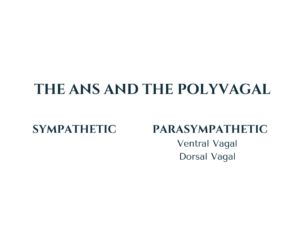The Polyvagal Theory (PVT), developed by Dr. Stephen Porges, is a neurbiological theory that brings significant shift in our understanding of the treatment of trauma, helping therapists understand how the Autonomic Nervous System (ANS) influences our responses to trauma, stress, social interactions, and affective and physiological regulation. Most significantly, it introduced therapists (and the world) to the concept that trauma forces the ANS into a neural state of immobility by involuntarily inciting the Dorsal Vagal System (DV), the unmyelinated, ancient part of the vagus nerve that is associated with immobilisation. Prior to Porges’ PVT, trauma was (and in some cases still is) misunderstood simply as an engagement of the fight flight response of the Sympathetic Nervous System (SNS).
In speaking or thinking about trauma, we understand that the neurophysiological self responds to traumatic experience by involuntarily shifting the ANS state. This shift is incited through the perception of threat that overwhelms the ANS and psyche, therefore it is not necessarily caused by the event, but is the result of our inability to stay safe, or feel safe, during the experience. There is an overwhelm to the system and its integrative capacities which disrupts the ability for the individual to metabolise the experience at the time.
We used to understand the ANS as two systems, the sympathetic and parasympathetic, but the PVT indicates that there are multiple states (poly) within the parasympathetic. To understand trauma we want to think about two of those states, the ventral and dorsal vagal states, both part of the parasympathetic system.
The PV theory proposes that our bodies use a hierarchical system of responses, with the ventral vagal system being the most evolved and socially engaged, followed by the sympathetic system for more intense stress situations, and finally the dorsal vagal system as a last resort in extreme danger. It also includes two hybrid systems which combine states of the ANS as in play and intimacy (see image below). The Polyvagal Theory asserts that the psyche operates out of different ANS states – in the moment of experience, as well as an overall generalised pattern or tendency, and our autonomic state is “a neural platform for behavior and psychological experiences, including feelings of being safe” (Porges, 2017, p.41). We also know that our autonomic state correlates with probabilistic behaviour and psychological feelings (Porges, 2017). We use unconscious neural processes to evaluate risk/safety in our environment.
- Social Engagement (Ventral Vagal) System: This branch is associated with feelings of safety and connection. When it’s active, we are more likely to engage with others, communicate effectively, and experience positive emotions. It supports social interaction and emotional regulation. We use engagement of this system to downregulate or upregulate the ANS in trauma therapy.
- Fight or Flight (Sympathetic Nervous System): In this state of high sympathetic arousal we move into fight and/or flight behaviour. Our heart rate increases and our body mobilises in ways to defend & protect ourselves.
- Immobility (Dorsal Vagal) System: This branch is associated with immobilisation – ranging from the feigning of death to the inability to mobilise a response/defend or escape and dissociation. When this system is dominant, it can lead to feelings of helplessness, dissociation, and emotional shutdown. It’s a survival response to extreme threat or trauma.
- Play (Ventral Vagal and Sympathetic) : This is a hybrid state, engaging both sympathetic arousal and ventral vagal, however defensive mobilisation is down-regulated through face-to-face connection or vocalisations that maintain the connection and neuroception of safety – indicating that play has not shifted into aggression.
- Intimacy (Ventral Vagal and Dorsal Vagal) : This is a prosocial state, a state of social/self engagement but requires a reduction in movement. When we involve the social engagement system, “we can even use the oldest system, which is immobilization, and we can be in the arms of someone we feel safe with” (Porges, 2017, p. 129).
We have to remember that these systems regulate the ANS in adaptive responses from the most recent to the most ancient – social engagement (the ventral vagal – VV), mobilisation (SNS), immobilisation with fear (DV). The PVT tells us that under threat or when unsafe, the ANS involuntarily shifts into a dorsal vagal dominant state which decreases arousal in terms of mobilisation and reflects a survival response (Porges, 2004).When the DV system is dominant, we can see a range of effects from a collapsed sense of self to tonic immobility depending on the event; the history, and the experience(s) of the person, and can lead to feelings of helplessness, hopelessness, shame, and dissociation. Porges refers to this as a portal to the death state (2017), however, when people survive the trauma (as most do), their DV often remains active in the ANS. Porges tells us that once the survival system (DV) is engaged, it “doesn’t have an efficient pathway to get out of it” (Porges, 2017, p. 106) thereby wreaking havoc in the ANS, and can create ongoing emotional, relational and physical or physiological symptoms.
Hopefully, this brief overview of the PVT has offered some insight into the workings of the ANS, particularly as it relates to trauma. Of course, understanding it and integrating it into your clinical practice are two different things. If this has piqued your interest, know that we work intimately with the PVT in our Bringing the Body into Practice trainings and workshops.
If your interest is piqued, and you want to know more about my trainings, here’s a link to the Somatic Attachment Psychotherapy training page
References:
Mortimore, L. (2018). Porges’ Polyvagal 5 States Made Simple Image, Somatic Attachment Psychotherapy Training Curriculum, The Savoy Clinic, Ltd.
Porges, S. (2004). Neuroception: A Subconscious System for Detecting Threats and Safety. Zero to Three. 24, 19-24.
Porges, S. W. (2017). The pocket guide to The Polyvagal Theory: The transformative power of feeling safe. W.W. Norton & Company, New York.


